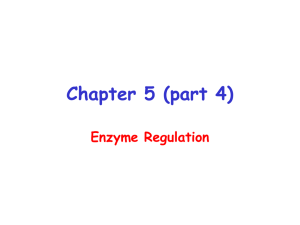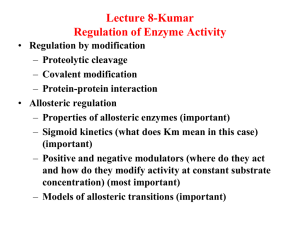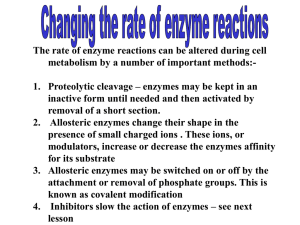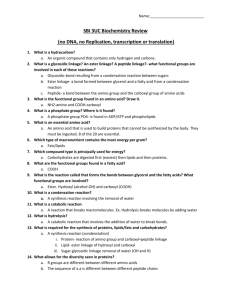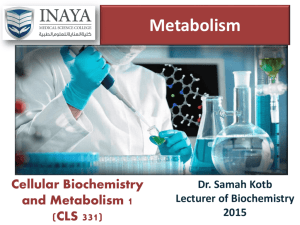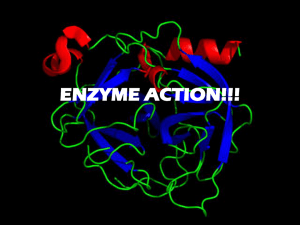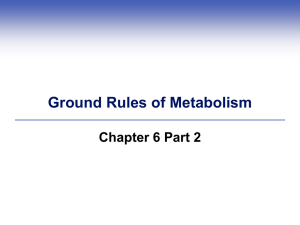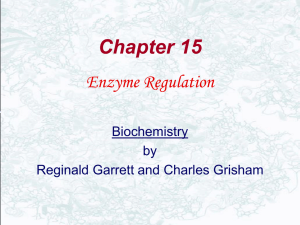Metabolic control 1
advertisement
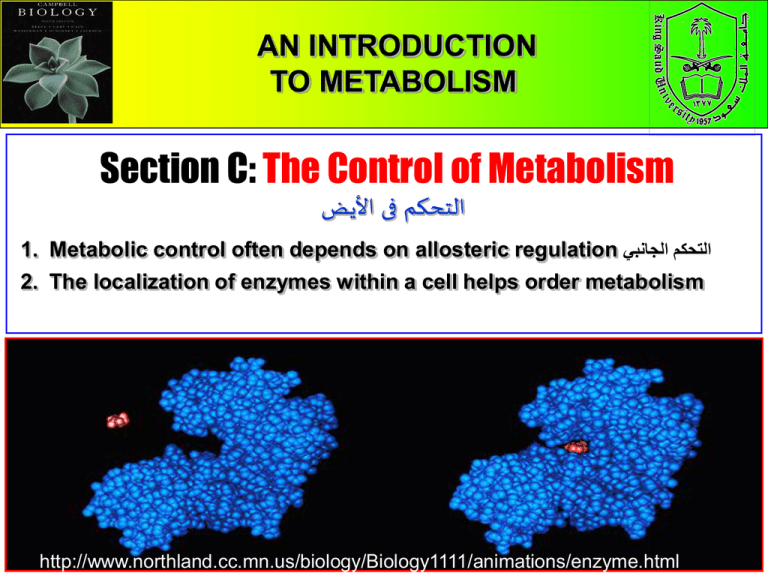
CHAPTER 5 AN INTRODUCTION THE STRUCTURE AND FUNCTION METABOLISM OFTO MACROMOLECULES Section C: The Control of Metabolism التحكم فى األيض 1. Metabolic control often depends on allosteric regulation التحكم الجانبي 2. The localization of enzymes within a cell helps order metabolism 1 Pages 96 - 103 http://www.northland.cc.mn.us/biology/Biology1111/animations/enzyme.html A)- Metabolic control • • • In many cases, the molecules that naturally regulate enzyme activity behave like reversible noncompetitive inhibitors. These molecules often bind weakly to an allosteric site which is a specific receptor on the enzyme that is not the active site. These molecules can either inhibit or stimulate enzyme activity. Allosteric site 1)- Allosteric Regulation: التنظيم األلوستيري • • • Most allosterically regulated enzymes are constructed of two or more polypeptide chains. Each subunit has its own active site. The allosteric sites are often located where subunits are joined. The whole protein exists in two conformational shapes, The active form, and the inactive form. 2 i)- Allosteric activators منشطات: It stabilizes the conformation that has a functional active site. ii)- Allosteric inhibitors مثبطات: It stabilizes the conformation that lacks an active site. • In many cases, both inhibitors and activators are similar enough in shape that they compete for the same allosteric sites. – These molecules may be products and substrates of a metabolic pathway. – For example, some catabolic pathways have allosteric sites that are inhibited when ATP binds, but activated when AMP (adenosine monophosphate) binds. – When ATP levels are low, AMP levels are high, and the pathway is turned on until ATP levels rise, AMP levels fall and inhibition by ATP occurs. 3 iii)- Feedback inhibition التثبيط باألثر الراجعي: It is one of the common methods of metabolic control in which a metabolic pathway is turned off يتوقفby its end product الناتج النهائي. • Example: The production of Isoleucine from Thereonine by Thereonine deaminase:• The end product acts as an inhibitor of an enzyme in the pathway. • When the product is abundant متوفر, the pathway is turned off, when rare قليلthe pathway is active. 4 B)- Cooperativity regulation التنظيم التضامني • It occurs in enzymes with multiple catalytic subunits. inding a substrate to one active site stabilizes favorable conformational changes at all other subunits, a process called cooperativity التضامنية. • This mechanism amplifies يـُزيدthe response استجابةof enzymes to substrates, making the enzymes accept additional إضافيsubstrates. 5 Summary of metabolic control (i.e. enzyme activity) The cell is controlling its metabolism by regulating enzyme activity: 1)- Allosteric Regulation: Regulatory molecules that bind weakly to an Alosteric site of the enzyme (Allosteric Enzymes) in order to inhibit or stimulate the enzyme activity (see Fig 6.18 carefully). A)- Allosteric activator. B)- Allosteric inhibitor C)- Feedback inhibition. 2- Cooperativity. Stabilizes favorable conformational changes at all other subunits to make the enzyme more efficient. http://www.northland.cc.mn.us/biology/Biology1111/animations/enzyme.html 6
